An important update is available for FreeStyle LibreLinkØ. Check here for more information.
 Menu
Menu
31 Mar 2020
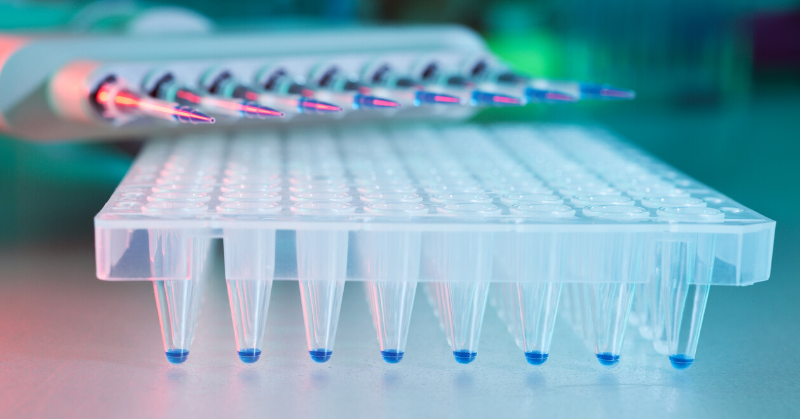
|
There are many steps during library preparation where human error can be introduced. These errors can negatively impact the reliability and accuracy of sequencing data and waste valuable samples. In this post we describe a few of these potential sources of errors and what happens to libraries when they occur.
Error #1: Adding one adapter to multiple samplesWhen a single barcoded adapter is accidently added to multiple samples during library prep the resulting sequencing data cannot be demultiplexed (Figure 1 and Figure 2). |
|
|
|
Figure 1. Indexing QC plot illustrating incorrect NGS library barcoding. This example of an Indexing QC plot shows what happens when the same barcode is added to two different samples and then sequenced on a single flow cell. In this instance, three sets of two samples have the same index sequence, generating double the expected percentage of reads identified for three of the indexes, and 0% reads identified for the remaining indexes.
|
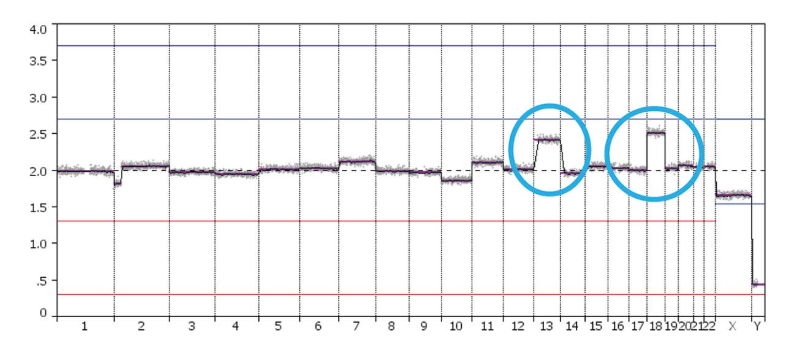 |
|
Figure 2. A genome graph of two samples were sequenced with the same index. This sample was thought to be 47,XY,+13 but on further investigation was found to be mixed with a 47,XX,+18 sample.
|
Error #2: Missing adaptersA sample could be accidently skipped when adding the adapters, resulting in no sequencing data being generated for that sample (Figure 3). |
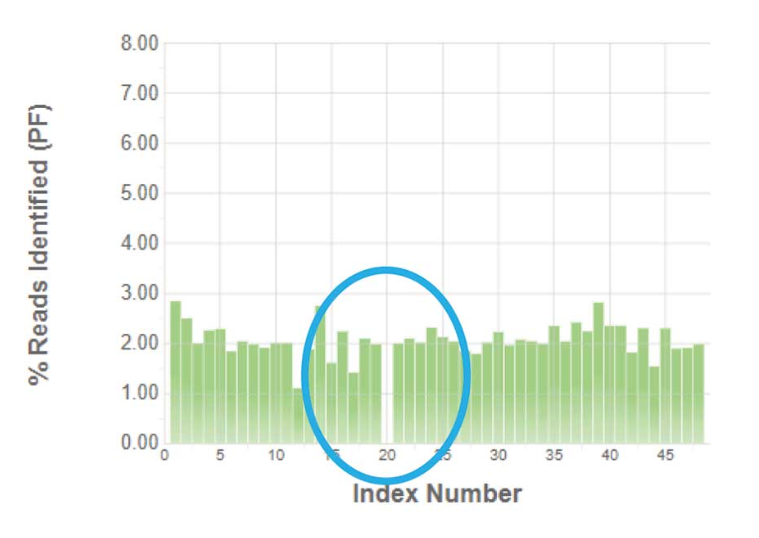 |
|
Figure 3. In this example sample 20 did not receive an adapter during adapter ligation and as a result generated no index reads or sequencing data.
|
Error #3: Over-drying purification beadsThe bead purification steps of library preparation need to be timed carefully. This can be difficult when preparing many libraries by hand simultaneously. If the library bead pellets are dried excessively, the DNA is much harder to resuspend from the beads and can sheer, causing a dramatic drop in yield.
|
Error #4: Washing the beads incorrectlyIf the beads are washed with incorrectly prepared ethanol, or with the wrong solution, the libraries can be lost. Not only must the ratio of ethanol to water be correct, ethanol needs to be diluted daily as older ethanol can absorb water from the air, changing its concentration.
|
Error #5: Adding reagents incorrectlyIf a sample does not receive all the correct reagents in the correct order the library preparation will fail (Table 1). Some mistakes which can be made include skipping a sample when adding reagents, adding the reagents in the incorrect order, and adding the wrong reagent volumes.
|
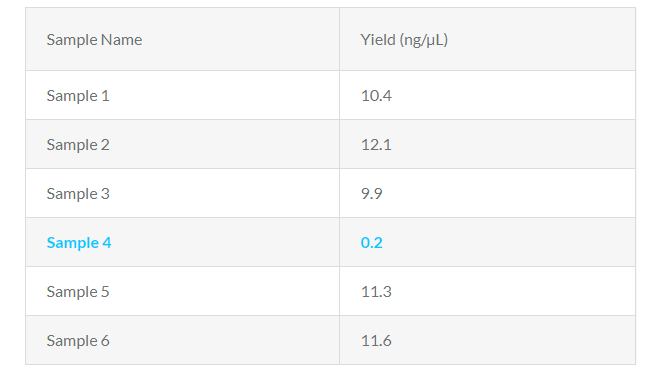 |
|
Table 1. This example shows the final library yield when sample four was accidently skipped when adding the adapter ligation mastermix. The adapters were unable to ligate, preventing this sample from being amplified and generating libraries during amplification.
|
Error #6: Poor pipetting accuracy & repeatabilityDifferent reagents used for library prep have different viscosities. Pipetting of viscous solutions can be difficult to pipette accurately which can lead to some samples receiving more or less reagents than specified.
|
Error #7: Mixing incorrectlyIn the example below, incomplete fragmentation occurred because the fragmentation enzyme and buffer were not mixed well with the sample. This results in large fragments which are unable to cluster on the flow cell delivering suboptimal yields (Figure 4). |
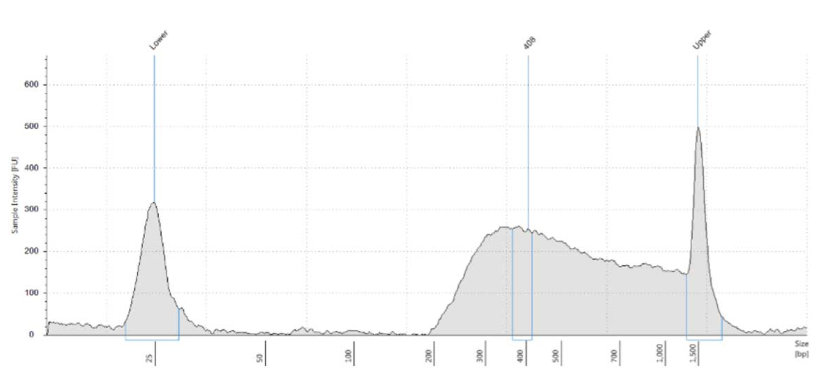 |
|
Figure 4. An electropherogram showing a sample with incomplete fragmentation due to suboptimal mixing. There are large fragments present which will be unable to undergo bridge amplification during cluster generation on the flow cell.
|
Error #8: Lag timeTiming of some library prep steps can be critical. However, when preparing many libraries by hand, increased sample variability can be introduced due to the lag between adding reagents to the first sample versus the last, especially with large batch sizes.
|
Error #9: Mixing up locations when transferring samples to microfuge platesAny number of mistakes can be made when plating samples. Samples can accidently be combined, skipped, or even discarded. This type of error is very difficult to identify.
|
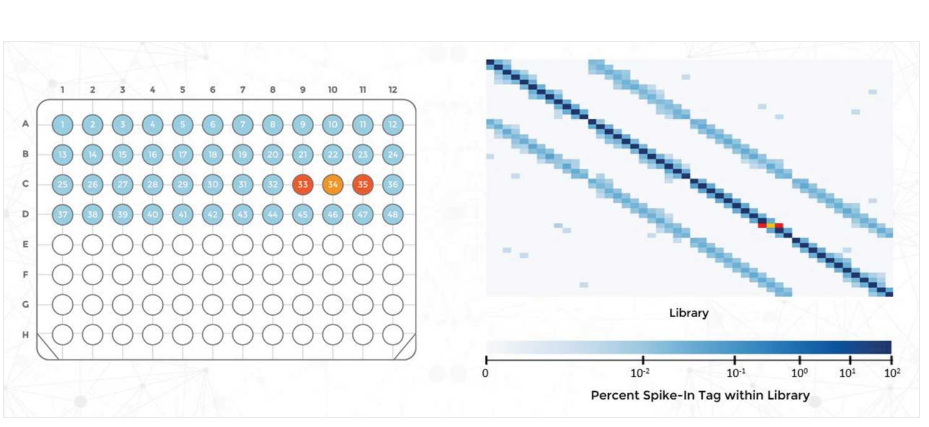 |
|
Figure 5. In this example, the sample in the orange well was accidently added to the wells adjacent to it on the microfuge plate prior to library construction. The only way to detect this type of error is adding spike-ins prior to samples prior to plating for library prep.
|
Error #10: Batch effectsBatch effects can be caused by variability introduced between different users due to individual pipetting or mixing methodologies. These batch effects can introduce unwanted variability into data.
|
Decreasing Human Error During Library PrepThere are many potential sources of human error in library preparation protocols which need to be minimized to ensure accurate sequencing data. The potential sources of human errors described above can all be eliminated by automating NGS library construction with a reliable liquid handler and automation scripts which have been standardized and tested. |
If you enjoyed reading our articles, why not sign up to our blog mailing list? You'll get new articles straight to your inbox as they're released!